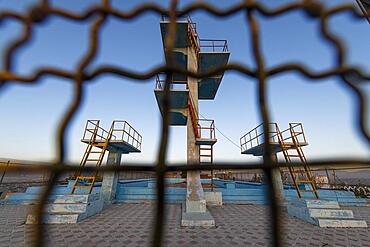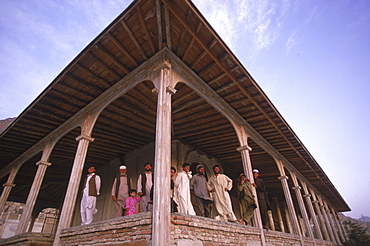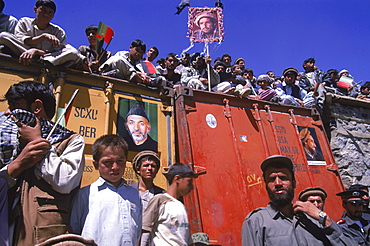Recent searches
Loading...
1350-5966 - Afghan family has fled Narkh district to maidan (capital of Wardak province) due to fighting between taliban and Hesb-i-islami.
1350-5965 - Afghan family has fled Narkh district to maidan (capital of Wardak province) due to fighting between taliban and Hesb-i-islami.
832-394306 - Former swimming pool where the Taliban were hanging their prisoners, Kabul, Afghanistan, Asia
1116-10699 - Large scaffolding for the emergency consolidation of the niche of the Small Buddha, destroyed by the Taliban in 2001 in Bamiyan, Bamian Province, Afghanistan
1116-10692 - Remains of the old Hazar bazaar destroyed by the Taliban in Bamiyan, Bamian Province, Afghanistan
1116-10689 - Panoramic view of Bamiyan and the escarpment with hundreds of caves and the niche that contained the Small Buddha statue destroyed by the Taliban in 2001, Bamian Province, Afghanistan
857-33945 - Men, soldiers and schoolboys carry banners and photos to the shrine in the Panjshir Valley of the famous Tajik commander, Ahmad Shah Masood, during a memorial on the one year anniversary of his assasination, September 9, 2002. Masood was a revered mujahedin leader who also was one of the leaders of the Northern Alliance which opposed the Taliban and helped the US Military in their defeat. Masood was assasinated by what are thought to be Al Queda operatives on Sept. 9, 2001. A shrine has been erected in the Panjshir Valley from where he led much of his resistance to both the Soviet and Taliban forces, to honor this latest of Afghan war heros.
857-33973 - Men and boys on bikes ride past a towering, ancient minaret, outside of Ghazni, Afghanistan, October 1, 2002. Made of brick decorated with Kufic and Naksh Script and floral motifs, the minaret dates back to the early 12th century and was built by Sultan Masud III of the Ghaznavid Dynasty, who ruled over an empire encompassing much of Afghanistan, Northern India, Persia and Central Asia. The minaret was once three times as tall as its current 70 feet, and is thought to have been part of a large mosque complex. Now an important truck stop on the road to Kandahar, Ghazni, located on the Lora River at the elevation of 2,225 meters, is the capital of Ghazni province and is a market for sheep, wool, camel hair cloth, corn, and fruit-it also continues to be a haven for Taliban insurgents.
857-34013 - Armed guards keep an eye on the crowds during a ceremony below the shrine of Ahmad Shah Masood in the Panjshir Valley, September 9, 2002. Masood was a revered mujahedin leader who fought the Soviets in the Afghan-Soviet war, and who also was one of the main leaders of the Northern Alliance which opposed the Taliban and helped the US Military in their defeat. Masood was assasinated by what are thought to be Al Queda operatives on Sept. 9, 2001. A shrine has been erected in the Panjshir Valley, near the village of Bazarak, from where he led much of his resistance to both the Soviet and Taliban forces, to honor this latest of Afghan war heros.
857-34008 - Workers pause by the columns of a 19th century summer pavilion in the Babur Gardens, or Bagh-i-Babur, Kabul, Afghanistan, September 25, 2002. The pavilion, which was used as a restaurant in the 20th century, was built by Amir Abdur Rahman, but was heavily damaged by the factional fighting of the mujihadeen in the 1990's and later by the Taliban. The buildings and gardens are now being carefully restored. Shah Babur, a descendent of Ghengis Khan and grandson of Tamerlane, is credited for founding the great Moghul dynasty which ruled India for two centuries. Babur built the palace and created the gardens on a hill looking over the southern part of Kabul in the 16th century,
857-33947 - Schoolboys chant and carry banners to the shrine in the Panjshir Valley of the famous Tajik commander, Ahmad Shah Masood, on the one year anniversary of his assasination, September 9 2002. Masood was a revered mujahedin leader who also was one of the leaders of the Northern Alliance which opposed the Taliban and helped the US Military in their defeat. Masood was assasinated by what are thought to be Al Queda operatives on Sept. 9, 2001. A shrine has been erected in the Panjshir Valley from where he led much of his resistance to both the Soviet and Taliban forces, to honor this latest of Afghan war heros.
857-34050 - Men sell melons, an Afghan specialty, along the partly ruined streets of Kabul, Afghanistan. Since the fall of the Taliban regime in late 2001, commerce has thrived in Kabul, if not in all the regions of Afghanistan. Agricultural products remains one of the most important parts of the Afghan economy
857-33952 - Crowds of boys and men, holding posters of Ahmad Shah Masood and Afghan president Hamid Karzai, line the roofs of buildings during a ceremony in the Panjshir Valley on the one year anniversary of Masoods assasination, September 9, 2002. Thousands of people from all over Afghanistan and the world, including many important dignitaries, arrived in the Panjshir Valley for ceremonies honoring Masood, a revered mujahedin leader who also was one of the leaders of the Northern Alliance which opposed the Taliban and helped the US Military in their defeat. Masood was assasinated by what are thought to be Al Queda operatives on Sept. 9, 2001. The shrine to honor this latest of Afghan war heros was built in the Panjshir Valley as that is from where Masood led much popular resistance against both the Soviets and the Taliban forces.
857-33946 - Hundreds of men and boys pray during ceremonies at the shrine of Ahmad Shah Masood in the Panjshir Valley, on the one year anniversary of his assasination, September 9, 2002.. Masood was a revered mujahedin leader who also was one of the leaders of the Northern Alliance which opposed the Taliban and helped the US Military in their defeat. Masood was assasinated by what are thought to be Al Queda operatives on Sept. 9, 2001. A shrine has been erected in the Panjshir Valley from where he led much of his resistance to both the Soviet and Taliban forces, to honor this latest of Afghan war heros.
857-34048 - Two school girls hurry across a street at dawn in Kabul, Afghanistan. Since the fall of the Taliban, a record number of girls have returned to school throughout Afghanistan. Much of Kabul was destroyed in the mid 1990's (1992-1996) in factional fighting between rival mujahideen commanders for control of the capital after the Soviet's withdrawal, and now Afghans are re-building their lives and business
857-33993 - Striking Mongol features distinguish the face of a woman and her child (who is blind) living in the ruins of the Qala-i-Dokthar (Daughter's Castle), outside of the town of Bamiyan, August 30, 2002. Most of the old town was destroyed and up to 20,000 people of the region might have perished when Bamiyan fell to the Taliban in 2001. Bamiyan Valley is located in the Hazarajat at the edge of the Koh-i-Baba range , the end of the Hindu Kush. Bamiyan was a prosperous Buddhist kingdom on the ancient Silk Road until the 10th century, when the region was converted to Islam; in the 12th century, it was destroyed by Ghengis Khan. Most of the people of this region are of the Hazara tribe, and are Shi'a Moslems who have been persecuted for centuries by many of the Pashtun rulers of Afghanistan, who are from the Sunni sect. They most recently suffered at the hand of the Taliban, who tried for years to ethnically cleanse the region of its Shi'a people.
857-33971 - Afghan men pause on the road with an ancient brick minaret and many shrines in the background, outside of Ghazni, Afghanistan, October 1, 2002. Made of brick decorated with Kufic and Naksh Script and floral motifs, the minaret dates back to the early 12th century and was built by Sultan Masud III of the Ghaznavid Dynasty, who ruled over an empire encompassing much of Afghanistan, Northern India, Persia and Central Asia. The minaret was once three times as tall as its current 70 feet, and is thought to have been part of a large mosque complex. Now an important truck stop on the road to Kandahar, Ghazni, located on the Lora River at the elevation of 2,225 meters, is the capital of Ghazni province with a population of 35,900, and is a market for sheep, wool, camel hair cloth, corn, and fruit, and continues to be a haven for Taliban insurgents.
857-33955 - Tajik farmers and their families thresh wheat with oxen and donkeys, in a side valley to the Panjshir Valley, in the Hindu Kush mountains, September 10, 2002. Agriculture is primitive and labor intensive in this remote valley. The Panjshir Valley and its side valleys have long been a stronghold for the Tajik people, and the famous commander Ahmed Shah Masood, in their struggle first against the Soviets and then against the Taliban. The Tajik are one of the larger ethnic groups in Afghanistan, second only to the Pashtun people.
857-33992 - Striking Mongol features distinguish the face of Hamir Mohammed, his daughter and grandson (who is blind), all living in the ruins of the Qala-i-Dokthar (Daughter's Castle), outside of the town of Bamiyan, August 30, 2002. Most of the old town was destroyed and up to 20,000 people of the region might have perished when Bamiyan fell to the Taliban in 2001. Bamiyan Valley is located in the Hazarajat at the edge of the Koh-i-Baba range , the end of the Hindu Kush. Bamiyan was a prosperous Buddhist kingdom on the ancient Silk Road until the 10th century, when the region was converted to Islam; in the 12th century, it was destroyed by Ghengis Khan. Most of the people of this region are of the Hazara tribe, and are Shi'a Moslems who have been persecuted for centuries by many of the Pashtun rulers of Afghanistan, who are from the Sunni sect. They most recently suffered at the hand of the Taliban, who tried for years to ethnically cleanse the region of its Shi'a people
857-34011 - Elaborate flower wreaths are brought by Afghan soldiers as tokens of respect to the shrine of Ahmad Shah Masood, on the one year anniversary of Masoods assasination, at a ceremony in the Panjshir Valley, Afghanistan, September 9, 2002. Masood was a revered mujahedin leader who fought the Soviets in the Afghan-Soviet war, and who also was one of the main leaders of the Northern Alliance which opposed the Taliban and helped the US Military in their defeat. Masood was assasinated by what are thought to be Al Queda operatives on Sept. 9, 2001. A shrine has been erected in the Panjshir Valley, near the village of Bazarak, from where he led much of his resistance to both the Soviet and Taliban forces, to honor this latest of Afghan war heros.
857-33942 - Children play on a tank in the Panjshir Valley while waiting for ceremonies to begin in honor the one year anniversary of the assasination of Ahmad Shah Masood, September 9, 2002. The Panjshir Valley was a stronghold for the Tajik people and the famous commander Masood in their struggle first against the Soviets and then against the Taliban. The valley and villages of the Panjshir were subjected to heavy bombing and destruction during the Afghan-Soviet war, but was never fully occupied. Now it is the heartland for the powerful Tajik ethnic group, the second largest in Afghanistan, who came to partial power after the fall of the Taliban.
857-33991 - A farmer with his donkey loaded with forage walks toward the setting sun above the town of Bamiyan, August 30, 2002. Most of the old town was destroyed and up to 20,000 people of the region might have perished when Bamiyan fell to the Taliban in 2001. Bamiyan Valley is located in the Hazarajat at the edge of the Koh-i-Baba range , the end of the Hindu Kush. Bamiyan was a prosperous Buddhist kingdom on the ancient Silk Road until the 10th century, when the region was converted to Islam; in the 12th century, it was destroyed by Ghengis Khan. Most of the people of this region are of the Hazara tribe, and are Shi'a Moslems who have been persecuted for centuries by many of the Pashtun rulers of Afghanistan, who are from the Sunni sect. They most recently suffered at the hand of the Taliban, who tried for years to ethnically cleanse the region of its Shi'a people
238-5192 - The giant Buddha image at Bamyan, UNESCO World Heritage Site, since destroyed by the Taliban, Bamiyan, Afghanistan., Asia
39-3524 - Cave painting at large Buddha cave before destruction by the Taliban, Bamiyan, UNESCO World Heritage Site, Afghanistan, Asia
39-3520 - Large Buddha, subsequently destroyed by the Taliban, Bamiyan, UNESCO World Heritage Site, Afghanistan, Asia
39-3508 - Small Buddha statue in cliff (since destroyed by the Taliban), Bamiyan, Afghanistan
39-3511 - Small Buddha statue in cliff (since destroyed by the Taliban), Bamiyan, Afghanistan
39-145 - The caves and 150ft tall statue of the Buddha at Bamiyan, since destroyed by the Taliban, UNESCO World Heritage Site, Afghanistan, Asia
2-5472 - Buddha statue in cliffs (since destroyed by the Taliban), Bamiyan, Afghanistan
6-2078 - Statue of Buddha, 38m high carved in the reign of Kanishka the Great, since destroyed by the Taliban, UNESCO World Heritage Site, Bamiyan, Afghanistan, Asia
6-2083 - Defaced statue of the Buddha, 55m tall, carved in cliff by monks, since destroyed by the Taliban, UNESCO World Heritage Site, Bamiyan, Afghanistan, Asia
76-1867 - Buddha at Bamiyan, UNESCO World Heritage Site, since destroyed by the Taliban, Bamiyan, Afghanistan, Asia
312-2271 - Empty niche in the cliff where one of the famous carved Buddhas once stood, destroyed by the Taliban in 2001, Bamiyan, UNESCO World Heritage Site, Bamiyan province, Afghanistan, Asia
312-1935 - Empty niche where one of the famous carved Buddhas once stood, destroyed by the Taliban, Bamiyan, UNESCO World Heritage Site, Afghanistan, Asia
312-1926 - View of Bamiyan showing cliffs with two empty niches where the famous carved Buddhas stood, since destroyed by the Taliban, UNESCO World Heritage Site, Afghanistan, Asia
312-2288 - Cliffs with empty niches where the famous carved Buddhas once stood, destroyed by the Taliban in 2001, Bamiyan, UNESCO World Heritage Site, Bamiyan province, Afghanistan, Asia
You reached the end of search results




































